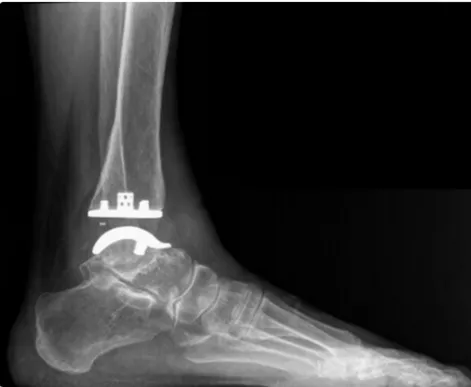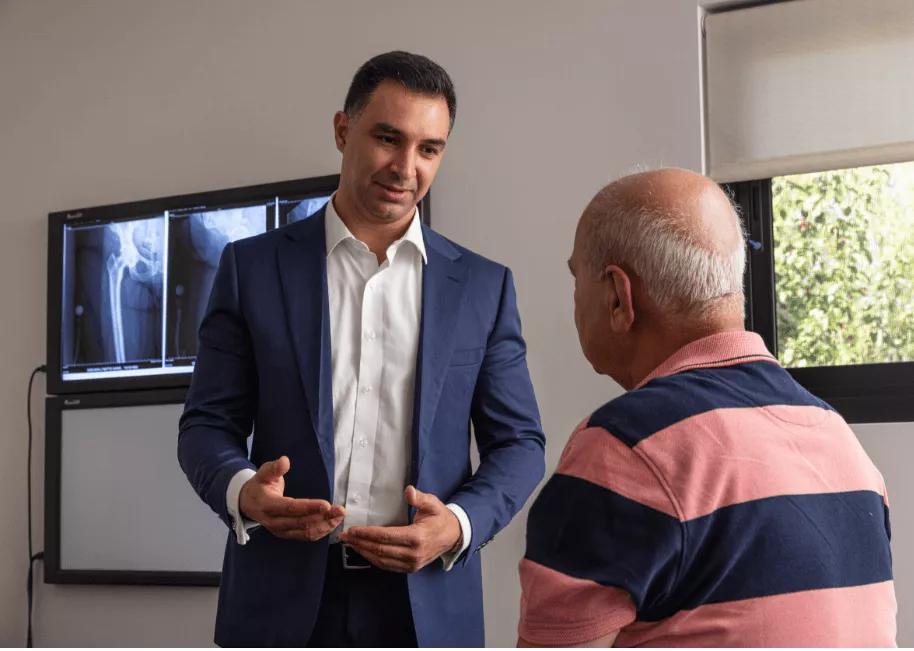Ankle Replacements
What is a Total Ankle Replacement?
A Total Ankle replacement an effective surgical option for the treatment of painful end stage ankle arthritis. This procedure replaces the damaged ankle joint with an artificial implant and is used to treat the pain of ankle arthritis while still maintaining motion.

What is the alternative to a Total Ankle Replacement?
Ankle fusion is the alternative to a total ankle replacement. This pain relieving procedure is performed by surgically joining the tibia (shin bone) and talus (ankle bone) with screws eliminating all motion in the joint.
The main advantage of this procedure is that it is strong, reliable and it relieves the pain associated with ankle arthritis. However, its main disadvantage is the loss of motion in the ankle joint increases the stress on the adjacent joints in the foot and ankle. This often results in the development of arthritis in these adjacent joints leading to further pain and stiffness in the foot and ankle over the long term.
What are the advantages of a Total Ankle Replacement?
Preservation of ankle motion while relieving pain is the main advantage of a total ankle replacement. This allows the patient to walk more normally as compared to an ankle fusion. Total ankle replacements have improved satisfaction rates and functional outcomes. Furthermore, this preservation of motion in the ankle and more normal walking motion reduces pressure on the surround joints therefore reducing the risk of developing arthritis in these adjacent joints.
What are the disadvantages of an Ankle Replacement?
The longevity of total ankle replacements is not the same as hip and knee replacements. Total ankle replacements have a higher revision rate however with new technology and techniques we are seeing improved results. Furthermore, Total Ankle replacements are not suitable for all cases or ankle arthritis. Patients with a history of infection, severe deformity, severely scarred skin, peripheral vascular disease, and neuropathy would get a better result from an ankle fusion.
Book an Appointment Today!
Do I qualify for a Total Ankle Replacement?
Dr. Chow will take a thorough history for which he needs to consider multiple factors to ensure that the appropriate operation is offered to you. Factors for consideration are age, activity level, type of arthritis, degree of deformity, quality of adjacent skin and if arthritis is present in both ankles.
A physical examination will be undertaken to evaluate the flexibility of the foot and ankle and isolate any other areas of pain and tenderness.
Weight bearing x-rays of the foot and ankle are reviewed for evidence of osteoarthritis and the bony alignment of the foot and ankle. A CT scan and MRI may be required to further investigate the foot and ankle prior to surgery.

There are clear indication and contraindications for total ankle replacement surgery however often patients fall into a grey area for which the ideal operation is not clear. Dr. Chow will take all factors into consideration and work with you to offer the most appropriate operation for your individual situation.
Do you use any technology for the Total Ankle Replacements?
The use of technology and evolution of modern total ankle replacements have vastly improved the outcome of total ankle replacements.
Dr. Chow utilize patient-specific instrumentation to perform your total ankle replacement. I perform a CT scan which is uploaded to specialized software in the united states. After I send my specifications engineers then design custom instruments to fit your specific ankle. This vastly improved the accuracy of the surgery and decreases operative time.

What should I expect after Total Ankle Replacement surgery?
You should expect to stay 2-3 nights in hospital for observation, pain relief and physiotherapy. You will be non-weightbearing for the first 2 weeks in a moon boot while the wounds heal and commenced on blood thinners to prevent clot formation.
Dressings are to remain dry and intact until your first post-operative appointment. At 2 weeks you will commence physiotherapy for range of motion and weightbearing in the boot until 6 weeks post operatively. Expect up to 6 months for the swelling to settle.
Potential complications of Total Ankle Replacement Arthritis surgery
All surgical procedures involve inherent risk of complications. However, these risks are generally uncommon and quite infrequent. These include anesthetic complications, wound infections, deep infections, nerve injuries, tendon injuries, bleeding, fracture, stiffness, chronic regional pain syndrome, blood clots, dislocation, component failure requiring revision surgery and development of arthritis in other joints of the foot and ankle.
Patients can minimize the risk of complications by carefully following post-operative instructions.
